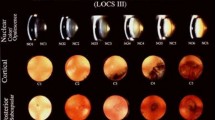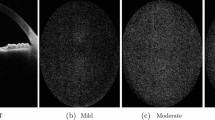Abstract
Cataract affects the quality of fundus images, especially the contrast, due to lens opacity. In this paper, we propose a scheme to enhance different cataractous retinal images to the same contrast as normal images, which can automatically choose the suitable enhancement model based on cataract grading. A multi-level cataract dataset is constructed via the degradation model with quantified contrast. Then, an adaptive enhancement strategy is introduced to choose among three enhancement networks based on a blurriness classifier. The blurriness grading loss is proposed in the enhancement models to further constrain the contrast of the enhanced images. During test, the well-trained blurriness classifier can assist in the selection of enhancement networks with specific enhancement ability. Our method performs the best on the synthetic paired data on PSNR, SSIM, and FSIM and has the best PIQE and FID on 406 clinical fundus images. There is a 7.78% improvement for our method compared with the second on the introduced \(P_{h}\) score without over-enhancement according to \(P_{oe}\), which demonstrates that the proper enhancement by our method is close to the high-quality images. The visual evaluation on multiple clinical datasets also shows the applicability of our method for different blurriness. The proposed method can benefit clinical diagnosis and improve the performance of computer-aided algorithms such as vessel tracking and vessel segmentation.











Similar content being viewed by others
References
Zhang J, Li H, Nie Q, Cheng L (2014) A retinal vessel boundary tracking method based on Bayesian theory and multi-scale line detection. Comput Med Imaging Graph 38(6):517–525
Cao L, Li H, Zhang Y, Zhang L, Xu L (2020) Hierarchical method for cataract grading based on retinal images using improved Haar wavelet. Information Fusion 53:196–208
Staal J, Abrámoff MD, Niemeijer M, Viergever MA, Van Ginneken B (2004) Ridge-based vessel segmentation in color images of the retina. IEEE Trans Med Imaging 23(4):501–509
Yang J-J, Li J, Shen R, Zeng Y, He J, Bi J, Li Y, Zhang Q, Peng L, Wang Q (2016) Exploiting ensemble learning for automatic cataract detection and grading. Comput Methods Prog Biomed 124:45–57
Setiawan, AW, Mengko, TR, Santoso, OS, Suksmono, AB (2013) Color retinal image enhancement using CLAHE. In: International conference on ICT for Smart Society, pp 1–3. IEEE
Cao L, Li H (2020) Enhancement of blurry retinal image based on non-uniform contrast stretching and intensity transfer. Medical & Biological Engineering & Computing 58(3):483–496
You, Q, Wan, C, Sun, J, Shen, J, Ye, H, Yu, Q (2019) Fundus image enhancement method based on CycleGAN. In: 2019 41st Annual international conference of the ieee engineering in medicine and biology society (EMBC):pp 4500–4503. IEEE
Cheng, P, Lin, L, Huang, Y, He, H, Luo, W, Tang, X (2023) Learning enhancement from degradation: a diffusion model for fundus image enhancement. arXiv:2303.04603
Shen Z, Fu H, Shen J, Shao L (2020) Modeling and enhancing low-quality retinal fundus images. IEEE Trans Med Imaging 40(3):996–1006
Deng Z, Cai Y, Chen L, Gong Z, Bao Q, Yao X, Fang D, Yang W, Zhang S, Ma L (2022) RFormer: transformer-based generative adversarial network for real fundus image restoration on a new clinical benchmark. IEEE Journal of Biomedical and Health Informatics 26(9):4645–4655
Zhou M, Jin K, Wang S, Ye J, Qian D (2017) Color retinal image enhancement based on luminosity and contrast adjustment. IEEE Trans Biomed Eng 65(3):521–527
Gupta B, Tiwari M (2019) Color retinal image enhancement using luminosity and quantile based contrast enhancement. Multidim Syst Sign Process 30(4):1829–1837
Zhang S, Webers CA, Berendschot TT (2022) A double-pass fundus reflection model for efficient single retinal image enhancement. Signal Process 192:108400
Xiong L, Li H, Xu L (2017) An enhancement method for color retinal images based on image formation model. Comput Methods Prog Biomed 143:137–150
Gaudio, A, Smailagic, A, Campilho, A (2020) Enhancement of retinal fundus images via pixel color amplification. In: Image analysis and recognition: 17th international conference, ICIAR 2020, Póvoa de Varzim, Portugal, June 24–26, 2020, Proceedings, Part II 17, pp 299–312. Springer
He K, Sun J, Tang X (2010) Single image haze removal using dark channel prior. IEEE Transactions on Pattern Analysis and Machine Intelligence 33(12):2341–2353
Cao L, Li H, Zhang Y (2020) Retinal image enhancement using low-pass filtering and \({\alpha }\)-rooting. Signal Process 170:107445
Zhu, J-Y, Park, T, Isola, P, Efros, AA (2017) Unpaired image-to-image translation using cycle-consistent adversarial networks. In: Proceedings of the IEEE international conference on computer vision, pp 2223–2232
Wan C, Zhou X, You Q, Sun J, Shen J, Zhu S, Jiang Q, Yang W (2022) Retinal image enhancement using cycle-constraint adversarial network. Frontiers in Medicine 8:2881
Yang B, Zhao H, Cao L, Liu H, Wang N, Li H (2023) Retinal image enhancement with artifact reduction and structure retention. Pattern Recogn 133:108968
Luo Y, Chen K, Liu L, Liu J, Mao J, Ke G, Sun M (2020) Dehaze of cataractous retinal images using an unpaired generative adversarial network. IEEE Journal of Biomedical and Health Informatics 24(12):3374–3383
Li, H, Liu, H, Hu, Y, Fu, H, Zhao, Y, Miao, H, Liu, J (2022) An annotation-free restoration network for cataractous fundus images. IEEE Transactions on Medical Imaging
Masruroh, SU, Rahman, DA, Putri, RA (2022) Systematic literature review: detecting cataract with deep learning. In: 2022 10th International conference on Cyber and IT service management (CITSM):pp 01–05. IEEE
Süleyman E (2020) Medical data analysis for different data types. International Journal of Computational and Experimental Science and Engineering 6(3):138–144
Zhou Y, Li G, Li H (2019) Automatic cataract classification using deep neural network with discrete state transition. IEEE Trans Med Imaging 39(2):436–446
Xu X, Li J, Guan Y, Zhao L, Zhao Q, Zhang L, Li L (2021) GLA-Net: a global-local attention network for automatic cataract classification. J Biomed Inform 124
Keenan TD, Chen Q, Agrón E, Tham Y-C, Goh JHL, Lei X, Ng YP, Liu Y, Xu X, Cheng C-Y et al (2022) DeepLensNet: deep learning automated diagnosis and quantitative classification of cataract type and severity. Ophthalmology 129(5):571–584
Son KY, Ko J, Kim E, Lee SY, Kim M-J, Han J, Shin E, Chung T-Y, Lim DH (2022) Deep learning-based cataract detection and grading from slit-lamp and retro-illumination photographs: model development and validation study. Ophthalmology Science 2(2)
Zhang, Y, Ding, L, Sharma, G (2017) HazeRD: an outdoor scene dataset and benchmark for single image dehazing. In: 2017 IEEE international conference on image processing (ICIP). IEEE, pp 3205–3209
He, K, Zhang, X, Ren, S, Sun, J (2016) Deep residual learning for image recognition. In: Proceedings of the IEEE conference on computer vision and pattern recognition, pp 770–778
Ronneberger, O, Fischer, P, Brox, T (2015) U-Net: convolutional networks for biomedical image segmentation. In: International conference on medical image computing and computer-assisted intervention, pp 234–241. Springer
Isola, P, Zhu, J-Y, Zhou, T, Efros, AA (2017) Image-to-image translation with conditional adversarial networks. In: Proceedings of the IEEE conference on computer vision and pattern recognition, pp 1125–1134
Ocular disease intelligent recognition ODIR-5K
Hore, A, Ziou, D (2010) Image quality metrics: PSNR vs. SSIM. In: 2010 20th International conference on pattern recognition, pp 2366–2369. IEEE
Wang Z, Bovik AC, Sheikh HR, Simoncelli EP (2004) Image quality assessment: from error visibility to structural similarity. IEEE Trans Image Process 13(4):600–612
Zhang L, Zhang L, Mou X, Zhang D (2011) FSIM: a feature similarity index for image quality assessment. IEEE Trans Image Process 20(8):2378–2386
Venkatanath, N, Praneeth, D, Bh, MC, Channappayya, SS, Medasani, SS (2015) Blind image quality evaluation using perception based features. In: 2015 Twenty first national conference on communications (NCC):pp 1–6. IEEE
Heusel, M, Ramsauer, H, Unterthiner, T, Nessler, B, Hochreiter, S (2017) GANs trained by a two time-scale update rule converge to a local Nash equilibrium. Advances in Neural Information Processing SSystems 30
Zhao, H, Yang, B, Cao, L, Li, H (2019) Data-driven enhancement of blurry retinal images via generative adversarial networks. In: International conference on medical image computing and computer-assisted intervention, pp 75–83. Springer
Shapiro SS, Wilk MB (1965) An analysis of variance test for normality (complete samples). Biometrika 52(3/4):591–611
Woolson, RF (2007) Wilcoxon signed-rank test. Wiley encyclopedia of clinical trials, pp 1–3
Funding
This work was supported by the National Natural Science Foundation of China (No. 82072007), the Key Scientific Research Projects of Colleges and Universities in Henan Province (No. 23A520011), and Key R &D and Promotion Projects of Henan Province (No. 232102211089).
Author information
Authors and Affiliations
Corresponding author
Ethics declarations
Conflict of interest
The authors declare no competing interests.
Additional information
Publisher's Note
Springer Nature remains neutral with regard to jurisdictional claims in published maps and institutional affiliations.
Rights and permissions
Springer Nature or its licensor (e.g. a society or other partner) holds exclusive rights to this article under a publishing agreement with the author(s) or other rightsholder(s); author self-archiving of the accepted manuscript version of this article is solely governed by the terms of such publishing agreement and applicable law.
About this article
Cite this article
Yang, B., Cao, L., Zhao, H. et al. Adaptive enhancement of cataractous retinal images for contrast standardization. Med Biol Eng Comput 62, 357–369 (2024). https://doi.org/10.1007/s11517-023-02937-5
Received:
Accepted:
Published:
Issue Date:
DOI: https://doi.org/10.1007/s11517-023-02937-5




